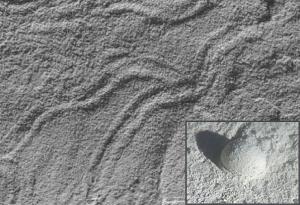While exploring the Bahamas, Mikhail Matzof the University of Texas at Austin discovered a new species of giant amoeba called Gromia sphaerica.

As the grape-sized protozoan rolls along the ocean floor, it sucks up and spits out sediment, leaving behind long grooves and ridges.
Watch a slideshow of the discovery and see a video of the amoeba here.
Similar tracks preserved in ancient mud have mystified palaeontologists. They had assumed that the only creatures with the physiology to make such grooves were ancestors of multicelled animals that seemed to evolve at lightning speed in the Cambrian explosion 525 million years ago.
But they have never found any fossils to match the traces. One theory to explain the anomaly is that the grooves were made by soft-bodied animals that left no skeletal trace in the fossil record. But the oldest of these tracks pre-date the evolution of multicellular life.
Matz believes that ancestors of his unicellular "sea grapes" explain the tracks better.
"Pretty much anything within the Precambrian fossil record can in principle be attributed to large protozoans," says Matz.
Journal reference: Current Biology (DOI: 10.1016/j.cub.2008.10.028)



Reader Comments
to our Newsletter